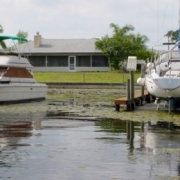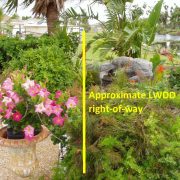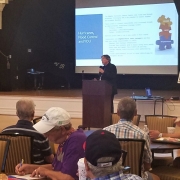
Recent hot and rainy Summer weather conditions have set the stage for algal blooms in our rivers, lakes, ponds, and canals. Like many people across the State, residents of the Lake Worth Drainage District (LWDD) may have concerns or confusion about these blooms. To help answer some frequently asked questions, we are providing the following information about algae.
Algae are simple organisms that grow through photosynthesis, a process by which sunlight is used to metabolize nutrients. Algae are a basic component of the food chain and are commonly found in marine, estuarine, freshwater lakes, canal systems, stormwater ponds and even swimming pools. Algae appear as green, red, or yellowish-brown particles that float on the water surface.
Although algae are a normal component of an aquatic ecosystem, nutrient-rich waters warmed by the sun provide a favorable medium for the overgrowth. This overgrowth is called an ‘algal bloom’. For algal blooms to occur two things must be present: high concentration of nutrients (nitrogen and phosphorus) and adequate sunlight. We cannot control sunlight, but we can limit our nutrient impact to surrounding waterbodies with proper maintenance of septic tank systems and limited use of fertilizers on landscapes and lawns. Currently approved herbicide or chemical treatments for the removal of algae uses a heavy metal compound that may adversely impact the waterbody. However, scientists are studying new treatments for the control of algae and safer alternatives may become available in the future.
While visually unappealing, most algae is not harmful to human health and provides a food source for aquatic life. However, some types, like “Blue-green” algae, which is a cyanobacteria, secrete toxins that may be harmful. The algae toxins can be inhaled by people living around the waterbody. It will aggravate respiratory illnesses like asthma. Symptoms of exposure to toxic algae include difficulty breathing, wheezing, skin rashes, headaches, and possible tingling in the fingers and toes. If water containing toxic algae is consumed potential liver damage may occur. It is important to keep humans and pets away from waterbodies that have toxic algal blooms and seek medical advice if symptoms appear.
Since most types of algae found within LWDD’s canals are non-toxic and do not impact flood control operations, LWDD does not regularly treat the canal system for algal blooms. Most algae growth in our canals is harmless and will dissipate on its own or will be flushed out of the canal system after a heavy rainfall.
Important phone numbers and links:
To report fish kills, contact the Florida Fish and Wildlife Research Institute at 1-800-636-0511.







